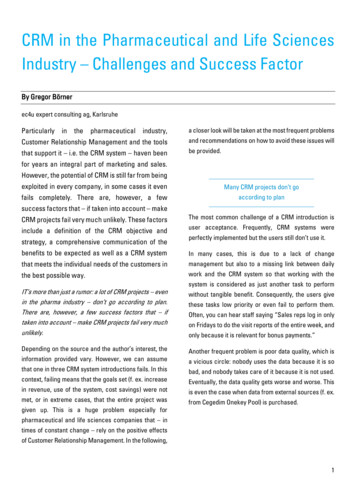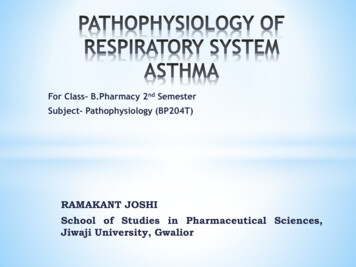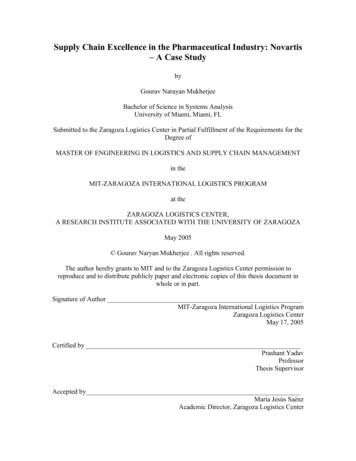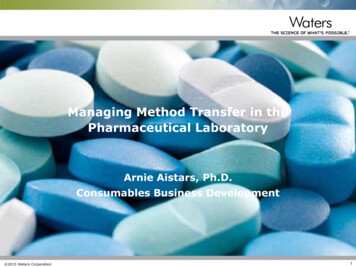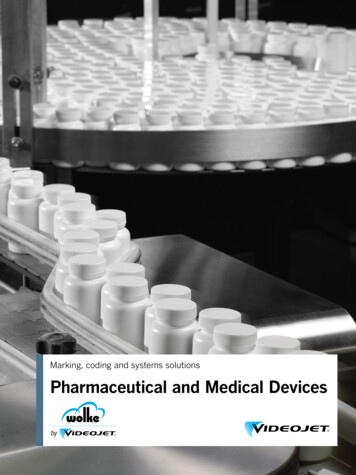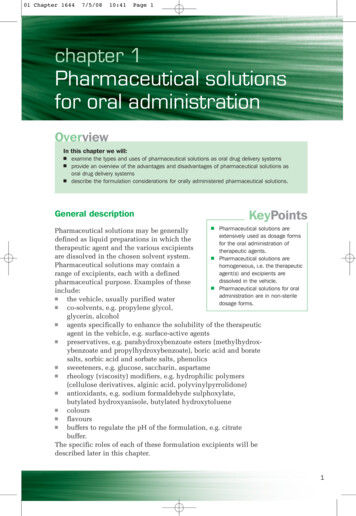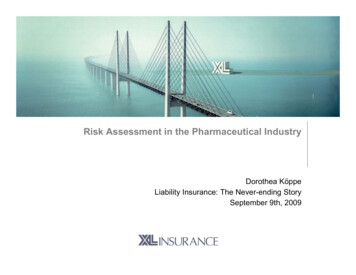
Transcription
Risk Assessment in the Pharmaceutical IndustryDorothea KöppeLiability Insurance: The Never-ending StorySeptember 9th, 2009
Risk Assessment in the Pharmaceutical Industry- the 6 W—————— 2009WERWASWANNWOWIEWARUM——————Page 2 10-Sep-09WHOWHATWHENWHEREHOWWHY
Definitions 2009Page 3 10-Sep-09
Definitions——Risk AnalysisRisk Assessment—————— 2009A systematic process of organizing information to support a riskdecision to be made within a risk management process. It consistsof the identification of the hazards, and the analysis and evaluationof risks associated with the exposure to these hazards (ICH Q9)Risk CommunicationRisk EvaluationRisk IdentificationRisk ManagementRisk ReductionPage 4 10-Sep-09
Risk Assessment in the Pharmaceutical Industry- WHYMission and Vision of a pharmaceutical company— We will bring to the world pharmaceutical and health careproducts that improve lives and deliver outstanding valueto our customers and shareholders 2009Page 5 10-Sep-09
Risk Assessment in the Pharmaceutical Industry- HOW—Pharmaceutical industry is driven by regulations o formal risk management tools adoptedFrom retrospective data to pro-active approach——— 2009WHOICHFDA / EMEA„Design space“ approach - manufacturingRMP (EU) – Risk Management PlanREMS (US) – Risk Evaluation and Mitigation StrategyPage 6 10-Sep-09
Risk Assessment in the Pharmaceutical Industry- WHOCEOProduct Safety(PVQP)Product Safety AProduct Safety BProduct Quality 2009Page 7 10-Sep-09
Risk Assessment in the Pharmaceutical Industry- WHO—Safety/Pharmacovigilance team—————— 2009Identification of adverse events and evaluation of safety signalsSafety reports for Health Authorities and Top rs/Physicians treating patientsDrug Safety Monitoring Board (DSMB)Global interdisciplinary project teamsPage 8 10-Sep-09
Risk Assessment in the Pharmaceutical Industry- WHATRisk or Risk-Benefit assessment?— Separate risk and benefit assessment——Clinical efficacy vs. adverse eventsQuantification of benefits and risks—Measured and valued differently 2009Patient & disease characteristics (age of patients, severity ofdisease)Benefit-risk over timeRisks of non-treatment or alternative productsPopulation risks and benefitsPage 9 10-Sep-09
Risk Assessment in the Pharmaceutical Industry- WHAT—Important non-clinical safetyfindings————Important potential risks——ToxicityGeneral pharmacologyDrug interactions———Adverse reactionsInteractions—Page 10 10-Sep-09Off-label useOverdose, misuse, abuseImportant missing informationImportant clinical safety finding— 2009—Non-clinical safety findings notaddressed by clinical data - relevance to the use inhumans?Age, gender, race
Risk Assessment in the Pharmaceutical Industry- WHAT——From safety signals to potential safety risksSafety signals that may warrant further investigation ——— 2009new unlabeled adverse events, especially if seriousapparent increase in the severity of a labeled eventoccurrence of serious events thought to be extremely rare in thegeneral populationnew product-product, product-device, product-food, or productdietary supplement interactionsidentification of a previously unrecognized at-risk population (e.g.,populations with specific racial or genetic predispositions or comorbidities)Page 11 10-Sep-09
Risk Assessment in the Pharmaceutical Industry- WHATImportant risk factors— Strength of the association (e.g. relative risk of the adverseevent associated with the product);— Temporal relationship of product use and the event;— Consistency of findings across available data sources;— Evidence of a dose-response for the effect;— Biologic plausibility;— Seriousness of the event relative to the disease beingtreated;— Potential to mitigate the risk in the population; 2009Page 12 10-Sep-09
Risk Assessment in the Pharmaceutical Industry- WHATFactors influencing the likelihood that the adverse eventrepresents a potential safety risk:— The frequency with which the event occurs (e.g., incidencerate, reporting rate, or other measures available);— The severity of the event;— The nature of the population(s) at risk;— The range of patients for which the product is indicated(broad range or selected populations only); and— The method by which the product is dispensed (throughpharmacies or performance linked systems only). 2009Page 13 10-Sep-09
Risk Assessment in the Pharmaceutical Industry- WHEN——Throughout the product’s life-cycle – from early developmentto ceasing the product’s marketing authorizationKey stop-go milestones———— 2009before FHDbefore start of phase III clinical trialsbefore filing Product labeling is the cornerstone of risk managementefforts for prescription drugs (FDA RiskMAPS)Page 14 10-Sep-09
Risk assessment in the pharmaceutical industry- ——————key role of pharmacovigilancesafety signalsoccurs during the whole product’s life-cyclegloballyguideline driven, no specific risk assessment toolssafe and effective products—— 2009PatientsshareholdersPage 15 10-Sep-09
— Risk Analysis — Risk Assessment — A systematic process of organizing information to support a risk decision to be made within a risk management process. It consists of the identification of the hazards, and the analysis and evaluation of risks associated with the exposure to these hazards (ICH Q9) — Risk Communication — Risk EvaluationFile Size: 217KBPage Count: 15



